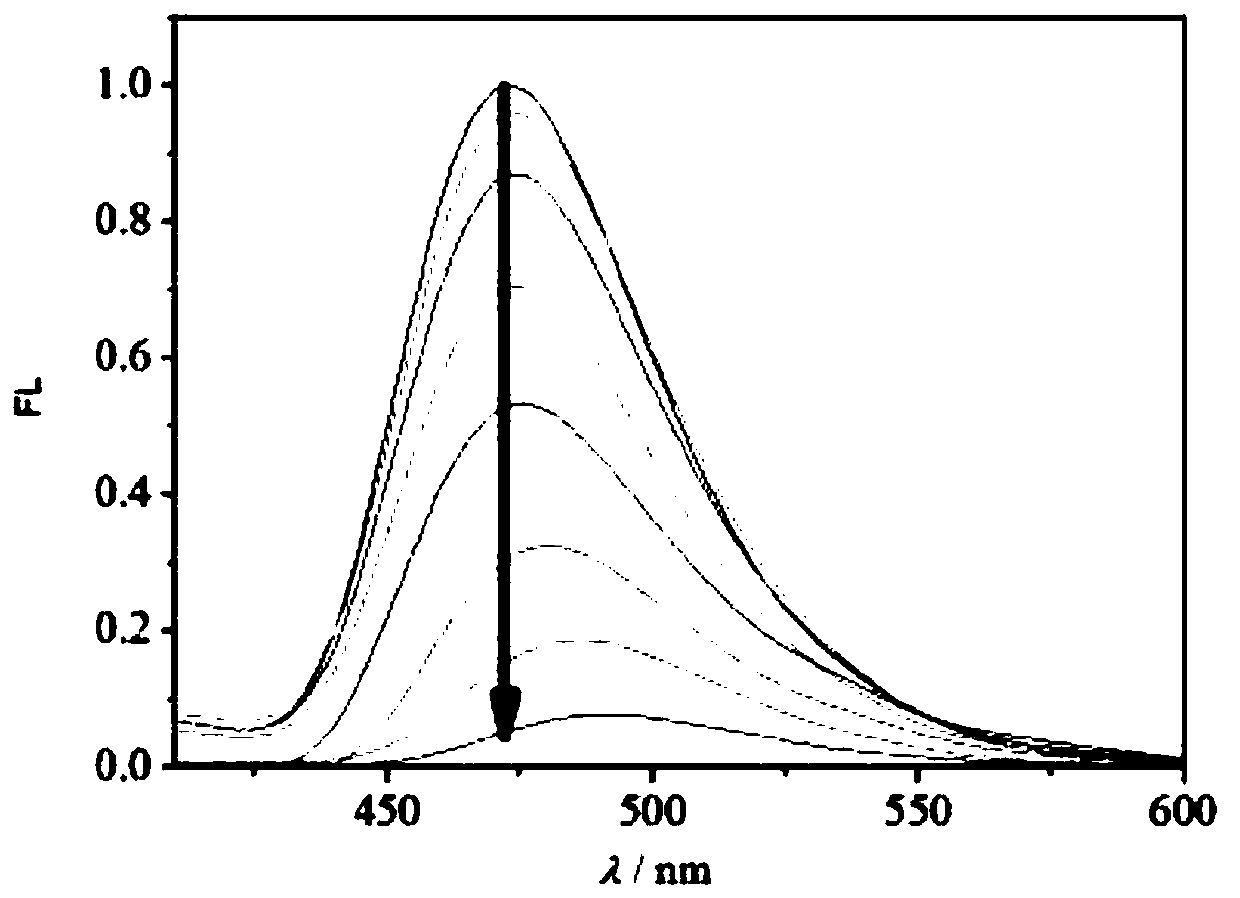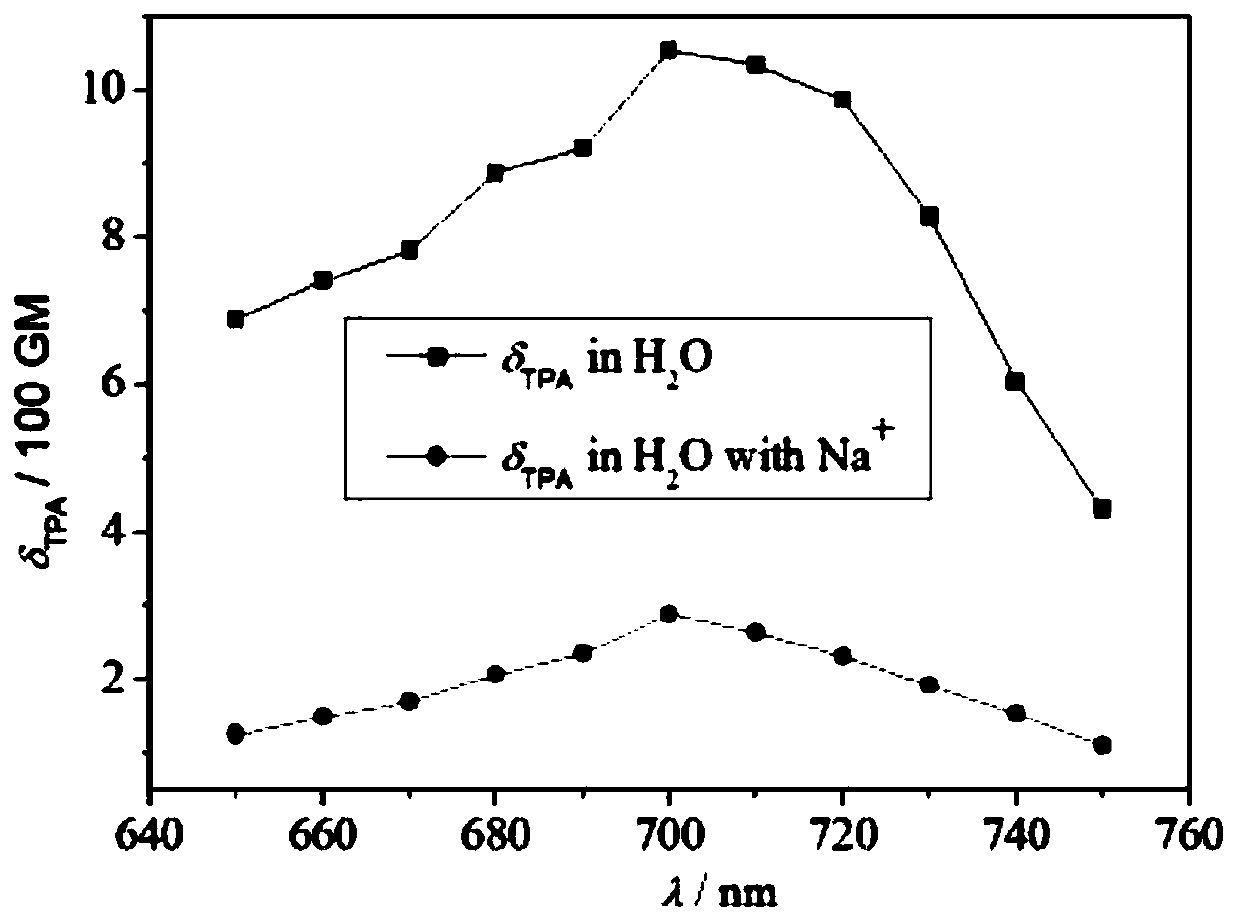Two-photon fluorescent sodium ion probe and its synthesis method and application
A technology of two-photon fluorescence and synthesis method, which is applied in the field of two-photon fluorescence sodium ion probe and its synthesis, can solve the problems of inability to identify and detect specific ions, poor water solubility of the probe, and not reaching the ideal, so as to improve the clarity, cell Good permeability and short response time
- Summary
- Abstract
- Description
- Claims
- Application Information
AI Technical Summary
Problems solved by technology
Method used
Image
Examples
Embodiment 1
[0042] Embodiment 1 Molecular structure and synthetic route
[0043] A two-photon fluorescent sodium ion probe PNa has the following molecular structure:
[0044]
[0045] The synthetic route is:
[0046]
[0047] Among them, intermediates 2 and 3 were synthesized according to the following document 1, and intermediates 4 and 5 were synthesized according to the following document 2: 6, namely 4'-formylbenzo-15-crown-5, was purchased from Shanghai Lanjun Biotechnology Co., Ltd.
[0048] [1] H. Huang, Q. He, H. Lin, F. Bai, Z. Sun and Q. Li, Polym. Adv. Technol., 2004, 15 (): 84—88
[0049] [2] Huang C., Fan J., Peng X., Lin Z., Guo B., Ren A., Cui J., Sun S., J. Photochem. Photobio. A: Chem., 2008, 199 (2) –3):144—149
Embodiment 2
[0050] The synthesis of embodiment 2 target compound PNa
[0051] Synthetic method: Accurately weigh 6 (296mg, 1mmol) and sodium hydride (30mg, 1.25mmol) in a 25mL dry single-necked flask, accurately weigh 5 (292mg, 1mmol) and dissolve in 10mL tetrahydrofuran, and place in a constant pressure feeder , Install the constant pressure feeder on the single-necked flask, and evacuate it with argon protection. The flask was placed in an ice-water bath, and the tetrahydrofuran solution of 5 was added dropwise to the mixed solution under the conditions of strong stirring and light protection (dropping time 40-50 min). After the dropwise addition was completed, the reaction was stirred at room temperature for 24 h. After the reaction, THF was removed in vacuo, extracted with dichloromethane (3×15 mL), washed with water (3×10 mL), and dried by adding anhydrous calcium chloride. Filter and remove solvent in vacuo. The crude product was separated by silica gel column chromatography [elu...
Embodiment 3
[0053] The photophysical property research in the water of embodiment 3 probe PNa
[0054] In order to study the fluorescence intensity of the probe PNa in water, the attached Figure 1-4 Experiments shown. at 1 μmol L - 1 In the aqueous solution of PNa, the single-photon absorption maximum wavelength was measured respectively single photon emission maximum wavelength fluorescence quantum yield Two-photon absorption cross-sections at different two-photon excitation wavelengths, and the Stokes shift (Δλ ST ), the maximum two-photon excitation wavelength and the maximum two-photon absorption cross section (δ max ).
[0055] Table 1 Photophysical properties of PNa
[0056]
[0057] Note: a) maximum wavelength of single photon absorption (nm); b) maximum wavelength of single photon emission (nm);
[0058] c) fluorescence quantum yield; d) maximum two-photon excitation wavelength (nm);
[0059] e) Stokes shift (nm); f) maximum two-photon absorption cross section (...
PUM
 Login to View More
Login to View More Abstract
Description
Claims
Application Information
 Login to View More
Login to View More - R&D
- Intellectual Property
- Life Sciences
- Materials
- Tech Scout
- Unparalleled Data Quality
- Higher Quality Content
- 60% Fewer Hallucinations
Browse by: Latest US Patents, China's latest patents, Technical Efficacy Thesaurus, Application Domain, Technology Topic, Popular Technical Reports.
© 2025 PatSnap. All rights reserved.Legal|Privacy policy|Modern Slavery Act Transparency Statement|Sitemap|About US| Contact US: help@patsnap.com



